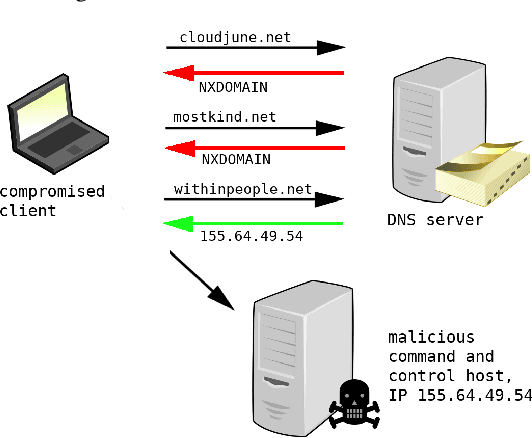Andrew B. Gardner
Detecting DGA domains with recurrent neural networks and side information
Oct 04, 2018



Abstract:Modern malware typically makes use of a domain generation algorithm (DGA) to avoid command and control domains or IPs being seized or sinkholed. This means that an infected system may attempt to access many domains in an attempt to contact the command and control server. Therefore, the automatic detection of DGA domains is an important task, both for the sake of blocking malicious domains and identifying compromised hosts. However, many DGAs use English wordlists to generate plausibly clean-looking domain names; this makes automatic detection difficult. In this work, we devise a notion of difficulty for DGA families called the smashword score; this measures how much a DGA family looks like English words. We find that this measure accurately reflects how much a DGA family's domains look like they are made from natural English words. We then describe our new modeling approach, which is a combination of a novel recurrent neural network architecture with domain registration side information. Our experiments show the model is capable of effectively identifying domains generated by difficult DGA families. Our experiments also show that our model outperforms existing approaches, and is able to reliably detect difficult DGA families such as matsnu, suppobox, rovnix, and others. The model's performance compared to the state of the art is best for DGA families that resemble English words. We believe that this model could either be used in a standalone DGA domain detector---such as an endpoint security application---or alternately the model could be used as a part of a larger malware detection system.
Detecting Adversarial Samples from Artifacts
Nov 15, 2017



Abstract:Deep neural networks (DNNs) are powerful nonlinear architectures that are known to be robust to random perturbations of the input. However, these models are vulnerable to adversarial perturbations--small input changes crafted explicitly to fool the model. In this paper, we ask whether a DNN can distinguish adversarial samples from their normal and noisy counterparts. We investigate model confidence on adversarial samples by looking at Bayesian uncertainty estimates, available in dropout neural networks, and by performing density estimation in the subspace of deep features learned by the model. The result is a method for implicit adversarial detection that is oblivious to the attack algorithm. We evaluate this method on a variety of standard datasets including MNIST and CIFAR-10 and show that it generalizes well across different architectures and attacks. Our findings report that 85-93% ROC-AUC can be achieved on a number of standard classification tasks with a negative class that consists of both normal and noisy samples.
 Add to Chrome
Add to Chrome Add to Firefox
Add to Firefox Add to Edge
Add to Edge